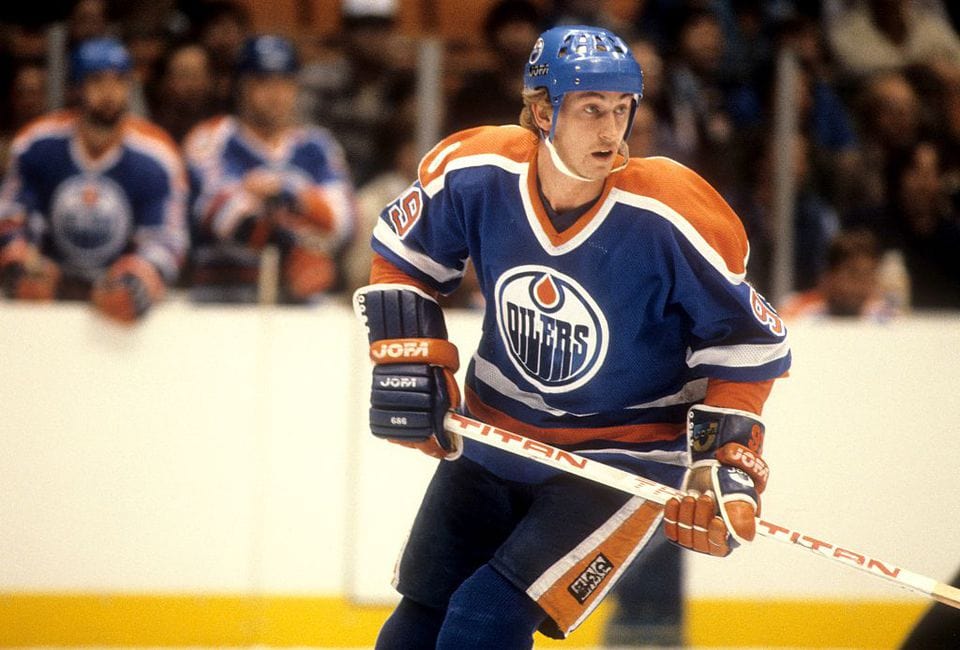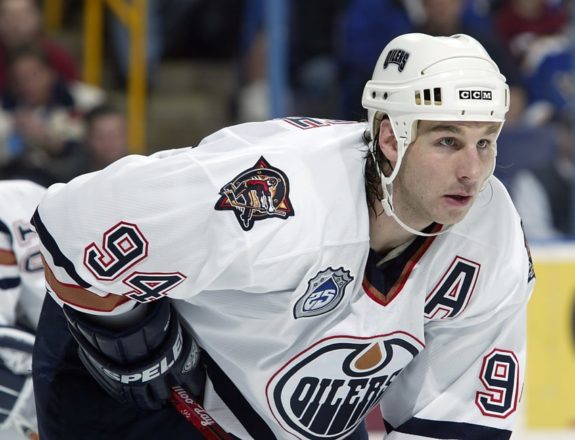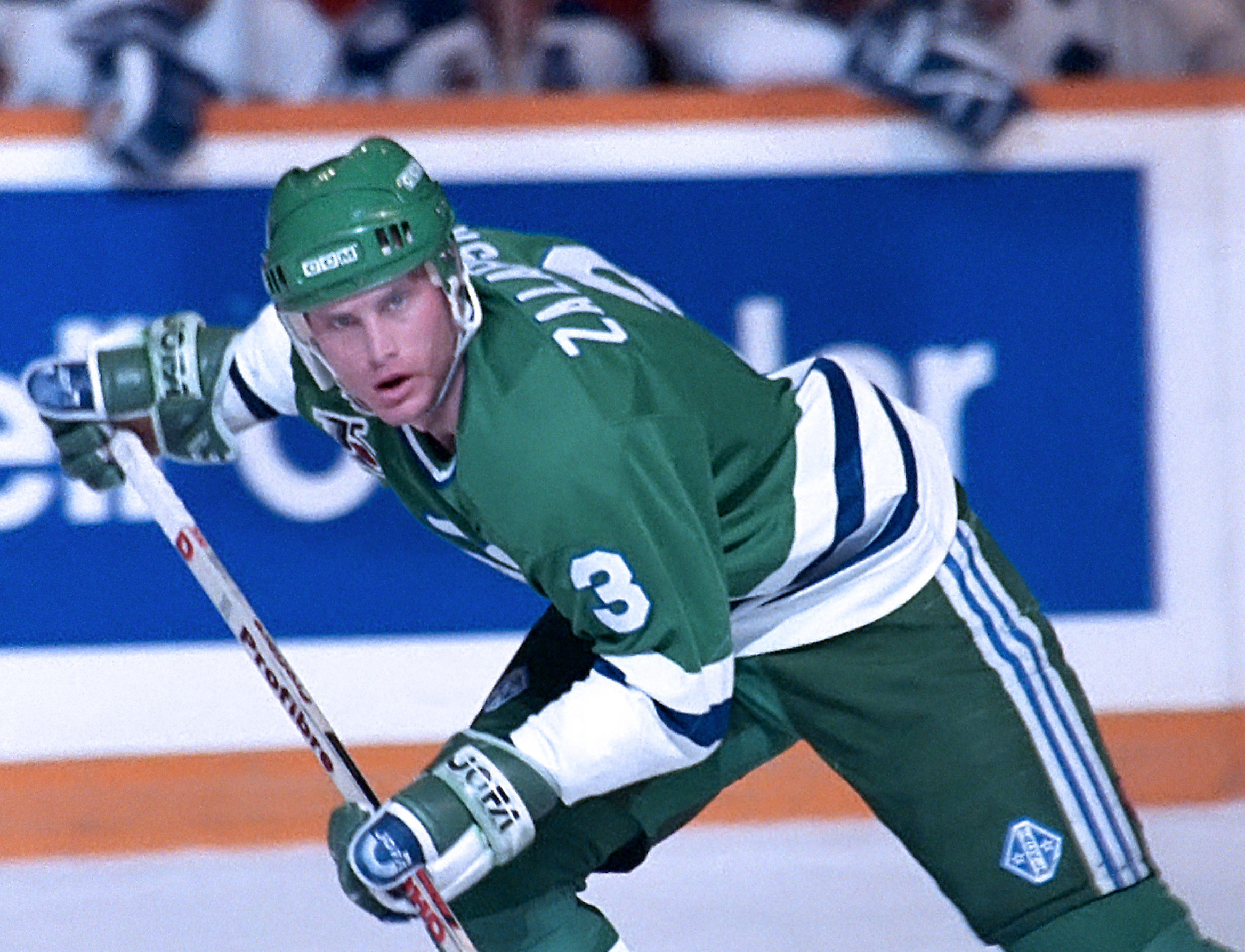Last month, the Edmonton Oilers unveiled their new alternate jersey that the team will wear seven times during the 2025-26 NHL season.
The jersey has a very traditional look, with elements evoking feelings of nostalgia. One minor detail, however, speaks volumes about how the Oilers approach their own history.
It’s found on the right shoulder of the jersey, where a patch comprises an oil derrick inside a roundel with lettering that reads ‘OIL COUNTRY’, ‘EDM’, and ‘1979’, which references the year Edmonton joined the NHL.
Related: Everything to Know About Oilers’ New Alternate Jersey
Effectively, the shoulder patch declares that Oil Country was established in 1979. But there’s one problem: the Oilers were around long before then.
From 1972-73 to 1978-79, the Oilers played in the World Hockey Association (WHA), a major league that tried to compete with the NHL for the top tier of professional hockey. Originally known as the Alberta Oilers, the team changed its identity to the Edmonton Oilers after one season.
After seven years of the WHA and NHL going head-to-head, the leagues merged in 1979. Four WHA teams – the Oilers, New England Whalers, Quebec Nordiques and Winnipeg Jets – joined the NHL as expansion franchises for the 1979-80 season.
WHA Years Were Important for Oilers
The Oilers’ WHA era is rich in significance for the franchise. Over seven WHA seasons, the Oilers made the postseason five times and advanced to the championship series once, losing to the Jets in 1979. Edmonton also finished atop the WHA regular season standings in 1978-79.
Four individuals who were part of the WHA-era Oilers are enshrined in the Hockey Hall of Fame: forwards Wayne Gretzky and Norm Ullman, goaltender Jacques Plante, and coach Glen Sather. The WHA Hall of Fame includes five individuals that were involved with the Oilers: Sather, Gretzky, defencemen Al Hamilton and Paul Shmyr, and franchise co-founder Bill Hunter. Edmonton goaltender Dave Dryden was named WHA MVP for the 1978-79 season.

The team played at the Edmonton Gardens for its first two seasons, before moving in 1974 to the iconic Northlands Coliseum, where the Oilers ultimately raised five Stanley Cup banners. Edmonton led the WHA in attendance three times, including 1978-79, when the Oilers set the WHA single-season attendance record by drawing 450,207 fans.
Oh, and Edmonton’s WHA era is also when the original earth-shaking trade in hockey history happened. A decade before trading Gretzky to the Los Angeles Kings, Edmonton acquired No. 99 from the Indianapolis Racers on Nov. 2, 1978. Gretzky’s arrival was transformational for team and city: The Oilers became arguably the greatest dynasty in hockey history; Edmonton became internationally known and globally relevant.
The WHA-NHL merger of 1979 marked the end of the historic first chapter of Oilers hockey. But from following the team today, you wouldn’t be well-versed in this chapter. In fact, you might not even know it’s part of the book.
Oilers Have Long Disregarded WHA Era
Disregarding their WHA history is nothing new for the Oilers. During the 1988-89 NHL season, the Oilers wore a “10th anniversary” patch on the shoulder of their jerseys. In 2003-04, Edmonton’s jerseys featured a “25” patch, which was just one of many initiatives commemorating the team’s 25th anniversary, including the inaugural Heritage Classic outdoor game. In 2008-09, the team’s jerseys included a shoulder patch “celebrating 30 years of Oilers hockey”.

Then, in 2018-19, the Oilers sported a 40th anniversary patch, which included six of the franchise’s seven retired numbers at that time: No. 7 (Paul Coffey), No. 9 (Glenn Anderson), No. 11 (Mark Messier), No. 17 (Jari Kurri), No. 31 (Grant Fuhr), and No. 99 (Gretzky). Conspicuously missing from the design, however, was Hamilton’s No. 3.
His omission was quite telling: while Hamilton only played 31 games with the Oilers in the NHL, he was the heart and soul of the team during its WHA era. Hamilton played for the Oilers in all seven of their WHA seasons, and at the time of the NHL merger, the defenceman ranked as the franchise’s all-time leader in games played, assists, and points.
While the Oilers have celebrated all their significant NHL anniversaries, they have never recognized the 1972-73 inaugural season. Even in 2022-23, the team’s golden anniversary, there was no acknowledgment of “50 years of Oilers hockey”. It’s like those WHA years simply didn’t exist.
When Rogers Place opened in 2016, the team’s new arena included an Oilers Hall of Fame room. “We wanted to depict the past — of this great franchise — and the future,” Oilers owner Daryl Katz said at the time. But the Oilers Hall of Fame room featured nothing commemorating the WHA years.
The Oilers have made one notable nod to the WHA. In 2015-16 and 2016-17, the team’s final season at Northlands Coliseum and first season at Rogers Place, respectively, the Oilers wore an alternate jersey that was almost identical to their road WHA jerseys. The jersey made its grand debut at the 2015 NHL Draft, when No. 1 overall pick Connor McDavid put it on.
Edmonton’s WHA roots didn’t really factor into the marketing of the jersey, however. The jersey wasn’t promoted as a tribute to the WHA days; rather, the main selling feature was how cool it looked. That the jerseys were virtually the same as what the Oilers wore in their WHA days was almost like a coincidence, not an impetus.
Oilers Are Last Direct Link to WHA
It must be said that ignoring the WHA is not just an Oilers thing. The NHL has never had any kind of substantial initiatives recognizing its late rival league. In some ways, that’s understandable. After all, there was a lot of bad blood between the NHL and WHA during their seven years of co-existence. But that’s almost half a century ago now. It’s hard to imagine there is anyone still working in NHL HQ who harbours that ill will.
The Oilers are also in a very unique situation when it comes to the quartet of WHA teams that joined the NHL, because the other three franchises are all at least one additional step removed from their WHA history.
The New England Whalers, who were renamed the Hartford Whalers, moved in 1998 to Raleigh, where they are now known as the Carolina Hurricanes; the Quebec Nordiques moved in 1995 to Denver, where they are known as the Colorado Avalanche; and the original Winnipeg Jets have changed locations and changed names several times, first moving to Phoenix and becoming the Phoenix Coyotes, then rechristening themselves the Arizona Coyotes and bouncing around the desert from Glendale to Tempe, and finally in 2024 relocating to Salt Lake City, where they first played as Utah Hockey Club before adapting the Utah Mammoth moniker.

The Oilers are the last remaining direct link to the WHA. Which is just one more reason why Edmonton should celebrate its WHA roots.
With each passing year, the team’s incredible WHA history becomes increasingly at risk of being lost to time. Sadly, the hockey world is beginning to lose the people who were part of the WHA and were around to witness it. We need to celebrate these individuals and hear their stories while we still can.
There is now an entire generation of hockey fans that has had virtually no exposure to the WHA. If you quizzed those attending an Oilers game at Rogers Place this season, it would not be surprising if at least half of them didn’t even know what the WHA is.
None of this is to imply that there is a deliberate intent by the Oilers to retcon their history. But if they aren’t intentionally disregarding their WHA years, that means they just don’t care about them, which might be even worse.
The WHA is, was, and forever will be a big part of Edmonton’s hockey history. The Oilers need to start recognizing that.
